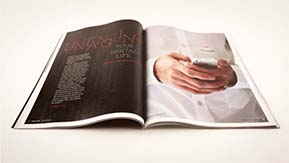Do as I say, not as I do
April 16th, 2018These days information pummels your senses at a breakneck pace, so much so that processing it all becomes a constant challenge. Conversely, the challenge for businesses looking to market their products and services is to find some way to break through that wave of data with their own message, hoping to say or do just the right thing to grab your attention and stop you in your tracks. But that’s often easier said than done.
For example, I regularly advise my clients to make extensive use of social media, keep their website content and advertising fresh and find new ways to get them to complement each other. I link their social media accounts to their website, reinforce their marketing message in their print and online advertising and support materials, and use each medium to reference the other, trying to strike that balance between “too much information” and “just enough” – and never repeating the exact same message in exactly the same way at any point along the way. (A Facebook post or Tweet might reference an event with a link to more extensive coverage on the client’s website, but each notice is unique to itself, with only minimal – if any – overlap, especially in photos and images. It’s important to keep each location tailored to its specific audience.) But keeping the information you present in various media up-to-date requires a commitment to curate it on a regular basis.
You need only take a look at this blog to see what happens when this commitment falls short. Although I started out with all the best intentions to regularly maintain the content here and on the main website itself – thankfully updated more often and more recently there than this blog, but still inadequately – there is absolutely no excuse for such long lapses in providing new content. (To be fair, the only excuse I could offer is I spend most of my time concentrating on my client’s efforts, not my own.) Were my business the type that is more dependent on steady web traffic and exposure than it is, a decline in viewership would translate to a decline in interest…and ultimately a decline in business itself. Thankfully, my clients “do as I say, not as I do” – but I’m holding my own work up as an example of what not to do because chances are you won’t be able to get away with it as I have. And, to be honest, I’m sure I’ve suffered as a result of these long lapses as well.
If you want people to read your blog, visit your website, join your mailing list, engage with you on social media, participate in your organization, or purchase your products and services, you have to be willing to put the time in to be active online. Even the briefest news update or Tweet can help, and if you’re overwhelmed by the prospect of juggling a presence in a variety of places at once, start small and build your audience one platform at a time. And realize that, with the proper hooks from one platform to the other, a Facebook post can also update your website, for example. Perhaps your ability to stretch your message across numerous platforms at once requires one person who’s responsible for Facebook and Twitter, another for your website, and yet another for your advertising and marketing. Or, if you’re a small business with limited staff (or a one-person shop), perhaps it’s best to set up your calendar to schedule specific tasks for specific days, say “Social Media Monday” or “Website Wednesday.” Whatever it takes, doing something is always better than doing nothing.
Just remember that anything worth doing is worth doing well. Better to update your website once a week with content someone will actually care about than once a day with trivial material just so you can say “it’s updated”. And save the Facebook and Twitter posts for when you really have something to say; “me too” posts won’t attract new fans or customers, but they just may get you more than your share of trolls. Or worse.
The bottom line is this: The more you put into your online effort, the more you’ll get out of it. Obviously, I can do a lot better job here, and with a little time and effort you can do a better job than me!



 But perhaps even more ironically, Fleishman has a
But perhaps even more ironically, Fleishman has a 
